

How to Enhance Your Media Company’s Performance with Salesforce
In media and advertising, the ability to monitor campaign performance, manage client initiatives with precision, and make decisions is critical.

Last updated on Thursday, June 2, 2022
Revenue and operational forecasting can be a huge challenge for organizations. Using an approach similar to the “art of deconstruction” enables companies to break down the bigger problem into smaller parts and more easily tackle each. In a previous post, we introduced “The 5 Cascading Challenges” of revenue and operational forecasting when revenue streams are tied to consumption or usage of a product or service offering.
Organizations continue to look to optimize their resources while having a more accurate prediction of future revenue. The greater the accuracy of their revenue forecasts, the greater their utilization of their resources required to deliver on the revenue-generating product or service. A corresponding operational forecast for things like human capacity (time), number of parts units required, demand planning, etc will provide higher profitability and the ability to more aggressively grow in the future.
When it comes to accurately forecasting revenue with a consumption or usage-based business model, there are five challenges that each cascade into the next creating a combinatorial effect. With the right disciplines and some support from revVana, these challenges become less daunting. Let’s look closer at the five challenges and how revVana can help for each.
Alternatively, book a 30-minute briefing for you and your team to discuss these challenges
There isn’t a sales leader that doesn’t lose sleep over this one. In today’s highly dynamic environment, very little seems predictable. However, as sure as the sun will rise, the company will sign business in the quarter and future revenue will result from this. Products like Salesforce Revenue Intelligence provide sales leaders tools to accurately track deal cycles, identifying where help is needed and what deals are at risk. Increasingly accurate sales booking forecasts will have an accretive effect on revenue forecasts but this is not the only driver.
revVana uses multiple sets of data for modeling future revenue forecasts. Your sales booking forecast is critical data that should be leveraged when predicting revenue. While the sales forecasts are not always perfect, revVana provides Finance with tools to factor them using their own set of assumptions layered on of the bookings forecast, in their entirety or by region, product or other sub-segment. revVana also allows Finance to continually adjust that factoring to achieve greater accuracy over time. While tools like Salesforce Revenue Intelligence enable Sales teams to increasingly predict the accuracy of contract closes, revVana enables Finance to increasingly weigh the potential impact of future revenue while it is still in the pipeline.
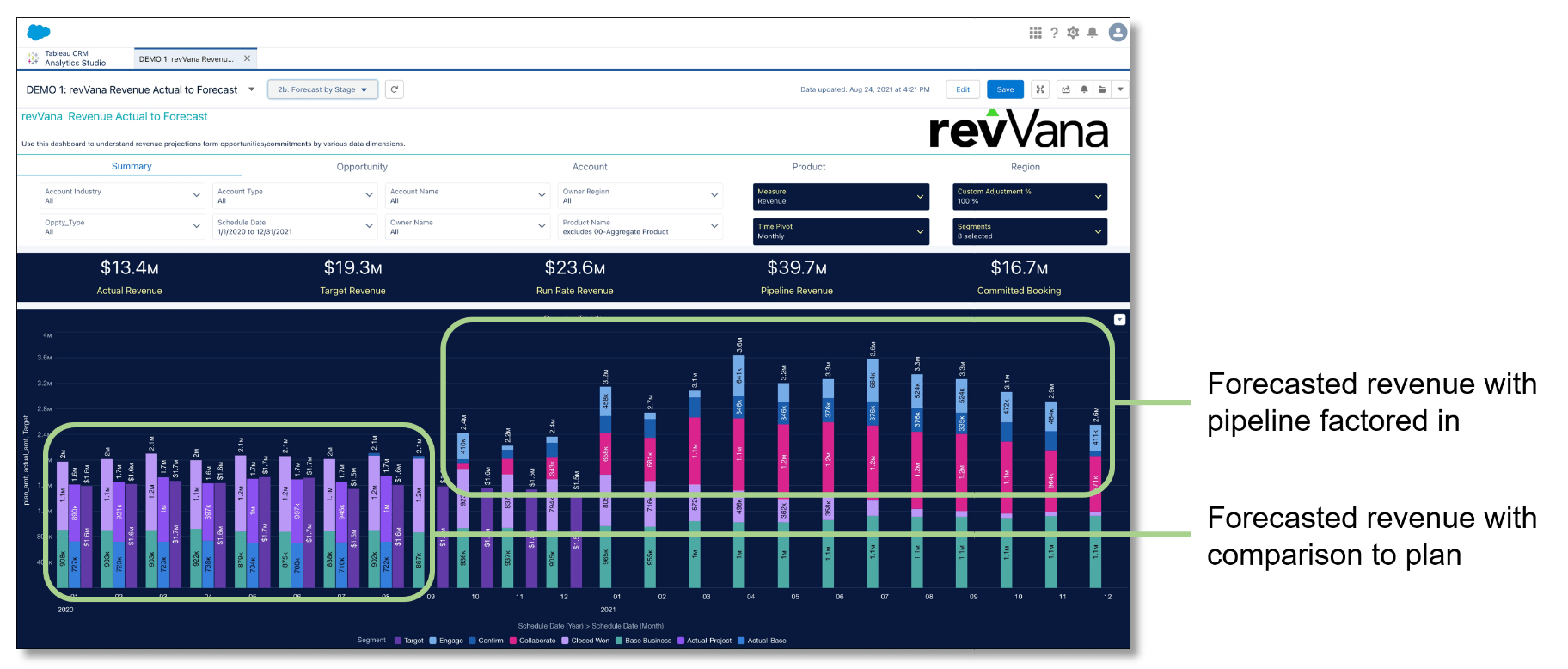
With consumption-based business models, companies contract for a product or service over a period of time-based on an agreed rate. As a result, it is hard to determine the actual revenue that it will ultimately produce until it is consumed. Typically, the estimated amount of revenue is called the “contract value” and is expressed annually (“ACV”). With usage-based pricing models, the total value isn’t necessarily contracted, just the rate is. The true contracted value will not be known until the revenue is fully realized.
revVana is able to model revenue realization or the yield of contracts based on historical analysis. Additionally, revVana is able to leverage this analysis if done in the past using other tools. This becomes another dataset for analysis. Further, many organizations invest a lot of time and effort in the pre-sale process to analyze prior usage patterns when determining pricing or pricing tiers. This data can also be leveraged in revVana to accurately predict the potential true realized revenue value from a customer contract.
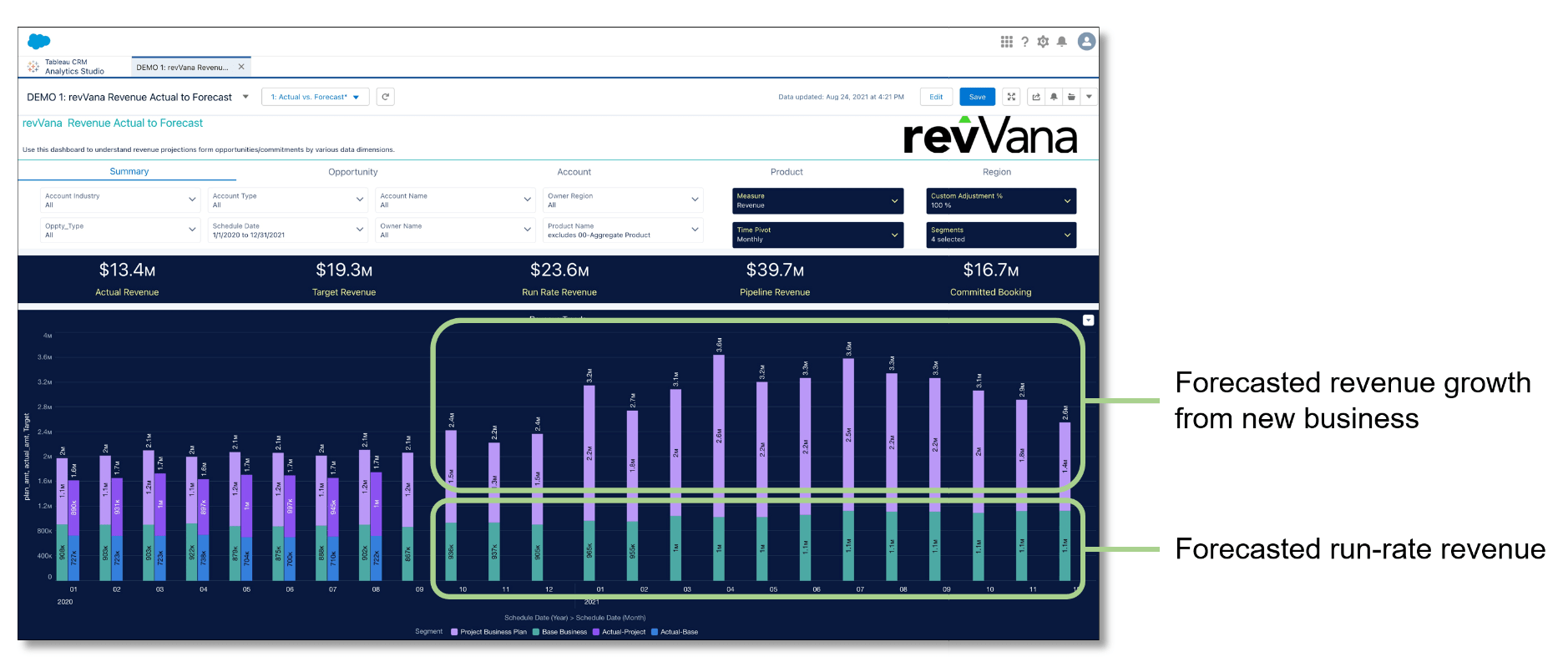
Picking up from the above, revenue realization becomes a difficult discipline because of the number of factors that could slow it down. With complex offerings, like a make-to-order part or a sophisticated API feed, there is a period of time needed to get the customer started. This is often a “black hole” for many organizations and is possibly the biggest impact to a missed revenue forecast. Often, this challenge is called “Ramp Latency” for the time that is taken before usage of the offering can start to ramp up. Incorporating the forecast of the ramp latency will improve revenue and operational forecasting, closely monitoring the project milestones associated with the implementation or activation of the offering will help.
Ramp latency is generally predictable but specifically hard to track due to the execution variability of projects. One approach to model ramp latency (or “time to live”) is by categorizing customers into similar groupings. For example “simpler” implementations typically take 2 weeks, “more sophisticated” ones may take 2 months. These categorizations, along with the corresponding data, is fed into revVana as a default plan. When “stuff happens”, those closest to the customer can simply update that plan in Salesforce at the Account-level, Opportunity-level or any other object. Any adjustments being made immediately and automatically update the revenue forecast. If the change is material, then a change control can track/log the changes to provide cross-enterprise context.
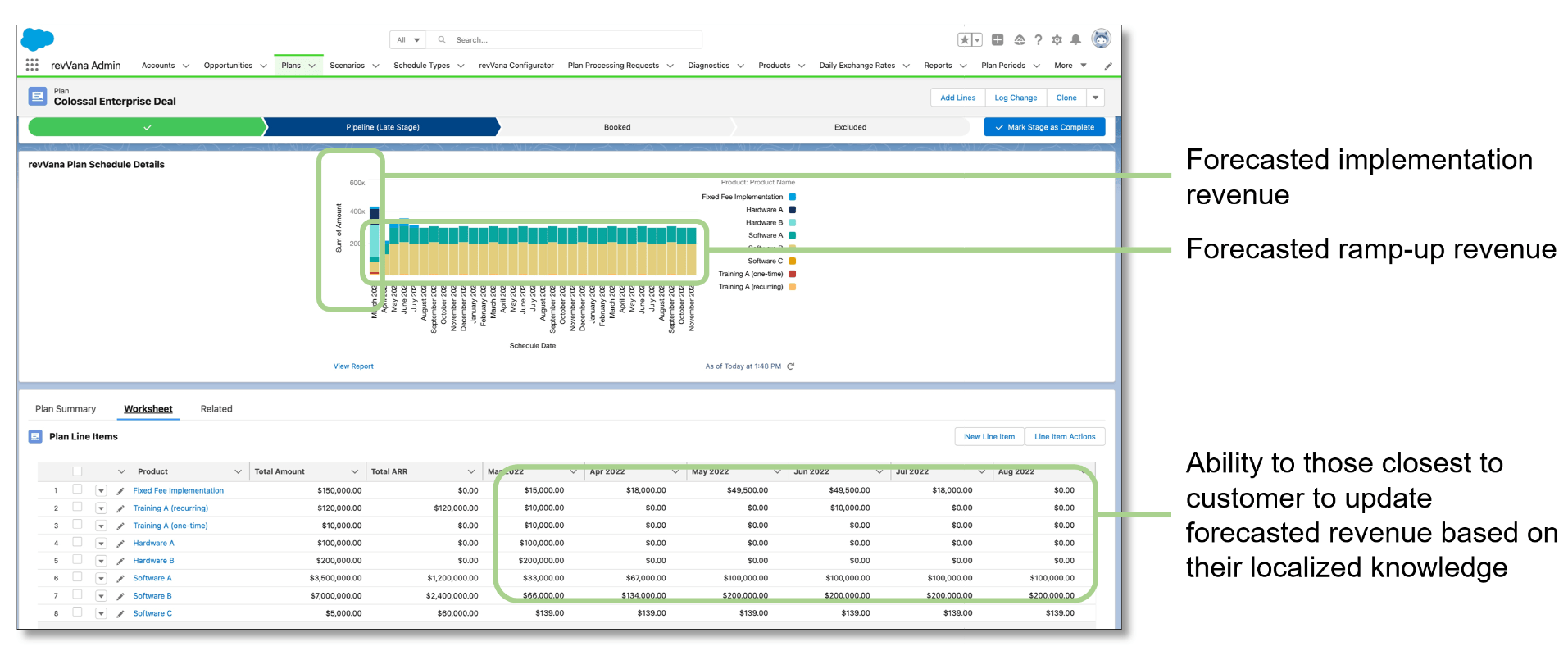
Every week, revVana gets the chance to help organizations model Ramp Latency, identify leading indicators and establish a better ability to manage Ramp Latency accuracy. If this is particularly challenging for your organization, let’s book a 30 min discussion to explore approaches that might help you improve it.
Once consumption or usage starts, the “Ramp-Up” period can be highly variable. When it comes to embracing new offerings in any given enterprise, there is usually a phased approach, either by department or by production line (in the case of a make-to-order part.) In most cases, there is often an already established plan to ramp up, but this knowledge is often localized to those closest to the customer and not being shared with finance. Should this plan be provided to Finance, it would allow them to model the expected ramp-up period with more accuracy. Still, nearly every plan deviates and there needs to be a way to keep Finance apprised as these changes happen.
In terms of modeling the ramp-up period of consumption, most companies can see patterns in how their customers gradually increase their usage. They are able to group customers that have common patterns into some broad categories (usually 5-7) that reflect a “curve” of increased usage. Some may ramp to 100% of expected usage very quickly, some may be incremental over the period of 6 months and, for others “oscillating curves” might be the best way to explain it. In this case, leveraging a % ramp per month over time for each category of clients will help track the realization of revenue and hence more accurate forecasting of it. Further, allowing those closest to the customer adjust those plans as they see changes will further increase accuracy.
For organizations that categorize their customers’ ramp-up, revVana can manage any number of categories (5 to 500). For each, a default monthly (or other period) ramp model is created (such as an assumed % of total ramp per month). These are applied to each customer based on details of the customer, products or other categorization. As the ramp-up occurs, those closest to the customer can adjust the forecasted amounts from within their Salesforce screens to provide greater accuracy. Further, adjustments made can be in the form of unit, usage or revenue forecasts, whichever is more natural to them, revVana does the translation These changes are then immediately and automatically reflected in the revenue forecast. Further, the resulting changes of a forecast can be used to continually improve the model for greater accuracy. Such changes to the model are performed by business users (with permissions) through a configurable screen.
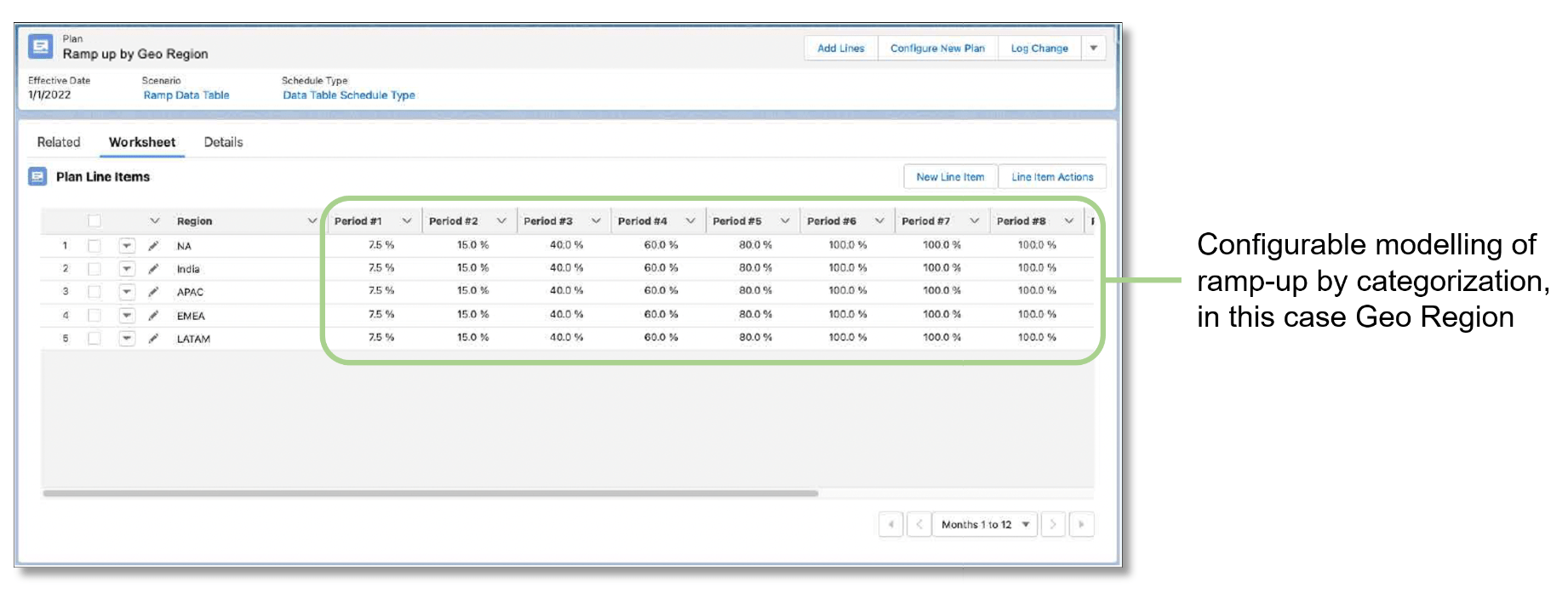
revVana has extensive experience in helping companies to start to model and categorize their customers as well as with guiding them to continually increase their accuracy. If this is a challenge that you face, then let’s book a 30 min discussion on how you can leverage the approaches used by others to increase their revenue forecasting during the Ramp-Up period.
Once a customer is “fully ramped” and realizing its full value of the contract, things get a bit easier but you are by no means “out of the woods” yet. Most customers have seasonality patterns which are fairly easy to predict and model. What is not as predictable is unforeseen events like acquisitions, divestitures, supply chain issues, and other global medical concerns that no one wants to talk about anymore. For this challenge, the key is to have seasonally adjusted patterns for each customer or category of customers and provide the field with an early warning system to alert adverse changes (acquisitions, divestitures, supply chain issues) that will impact the revenue forecast.
Seasonality-adjusted models can be applied within revVana at the product, account or other levels (category, region, etc) to provide automated revenue forecasting. Most importantly, these default forecasts are shared in the Salesforce Account pages of each customer and provide customer-facing teams with the ability to update those plans based on their most current knowledge. It’s easier than editing a cell in a spreadsheet. Once done, the change trickles through the entire enterprise, including finance as an automatically updated revenue forecast.
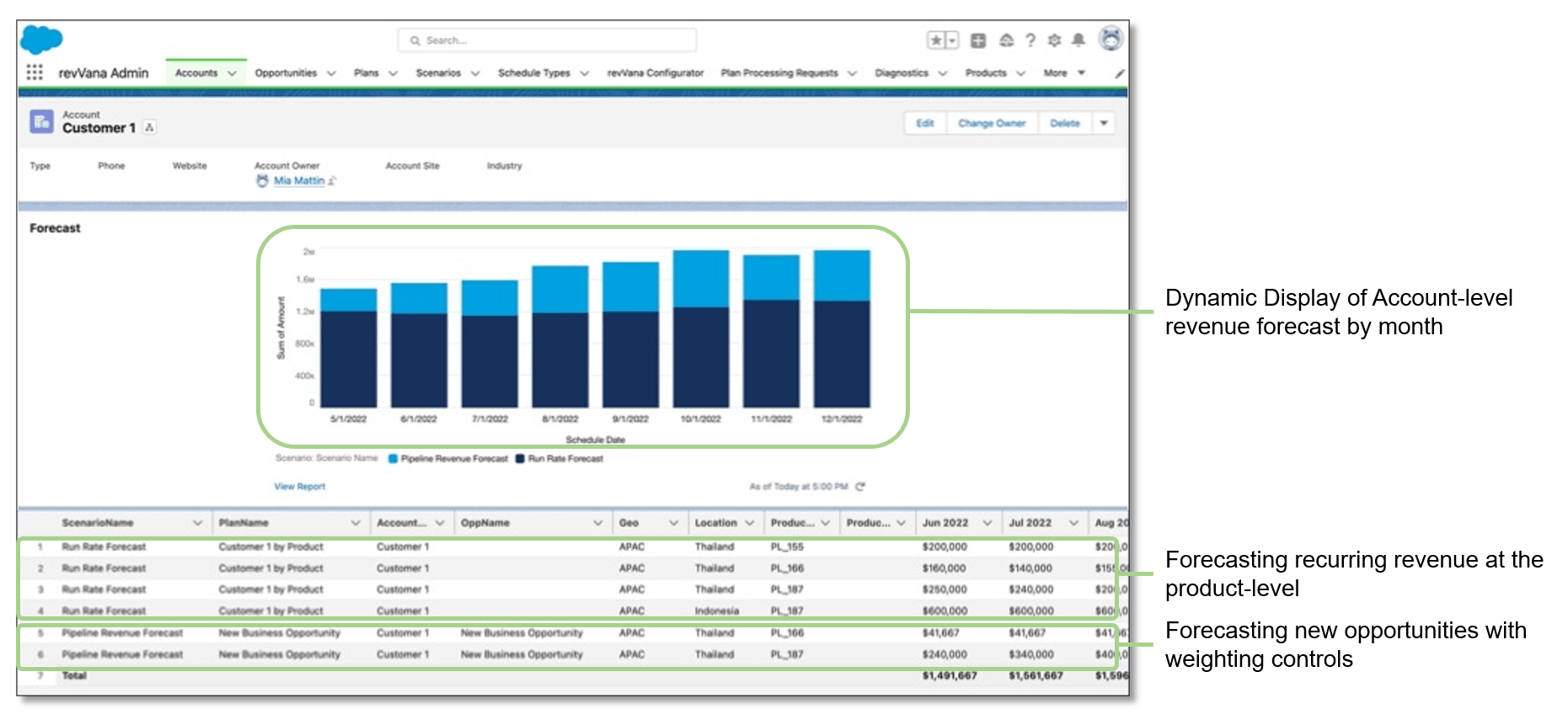
The above examples focus on revenue forecasting. revVana can be configured to align with a corresponding operational forecast for things like human capacity (time), number of parts units required, demand planning, etc. Leveraging both will provide higher profitability and provide the organization with the ability to grow more aggressively in the future.
While this article lists the challenges in a cascading order, most firms increase their forecast accuracy by picking one challenge, start with solving that challenge, and then adding other challenges after. For example, as mentioned above, “ramp latency” (Challenge #3) can often have the greatest impact on missed revenue forecasts. If this is the case, then focus on identifying the key milestones on the “time-to-live” journey and model the time latency from each.
A very common place to start is with ongoing run-rate revenue (Challenge #5) as this is often the least inspected and can have high variability without notice. Start with codifying accounts, segments of business, and other groupings that could change over time. With that, use automation to track the revenue run-rate to get greater visibility into fluctuations. Using a “snapshot” approach, track the accuracy of these automated models over time and use the variances to refine the models. It is also advantageous to introduce multiple scenario-based models to help predict the impact of these scenarios over time.
Many firms feel that they have a firm understanding of their run-rate business and see the greatest variance in the first year of “ramp-up” (Challenge #4). As outlined above, taking a logical categorization approach, modeling the curves, and then adjusting based on accuracy tests will yield the greatest results for tackling this challenge.
The key to approaching all of the challenges listed is to expect to analyze the accuracy of your models on a frequent basis and iterate on them to close the accuracy gap.
The revVana platform provides the ability to gather sets of data to model each stage of the revenue forecasting process, along with powerful automated modeling of this data. Analysis of the models can be done natively in Salesforce or using advanced analytics tools like Salesforce CRM Analytics or external analytics tools.
The functions described throughout this article enable you to have increasing confidence with your revenue and operational forecasts. Using the revVana platform for iterative analysis on accuracy enables you to continuously refine the assumptions in your models. Changing these is done by the business user through high degrees of configuration and a user-controlled “rules engine”.
In addition to its powerful platform, revVana also has extensive experience from helping companies in a variety of industries solve their revenue and operational forecasting challenges. We also team with the leading partners in the Salesforce ecosystem to provide a comprehensive product and services offering.
Revenue and operational forecasting is like the “art of deconstruction”, solving big problems by breaking them down into smaller problems. By tackling these Five Cascading Challenges, your revenue forecasts will be more accurate and you will also be able to provide greater clarity in regard to the operating requirements as a result.